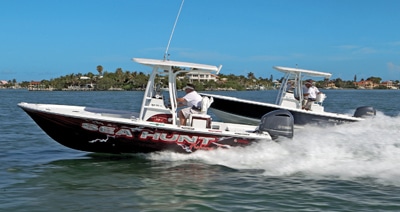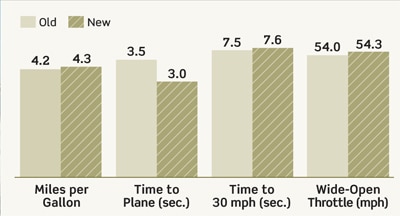In the motor world, where the axiom “Better is the enemy of best” is true more often than not, engineers can never rest on their accomplishments. So there was a logical question we wanted answered at the midsummer introduction of the new Yamaha 250s in Marathon, Florida.
“Why take the risk of fixing what ain’t broke?”
Yamaha’s engineers had a simple answer. They believed they could erode the two-stroke advantages of lighter, quicker and faster out of the hole and extend their line of four-stroke outboards in the performance-driven bass fishing arena. And they’d have to do it to move bass fishermen to their fourstroke and away from the HPDI they plan to eliminate.
Our test platform was an identical pair of Sea Hunt 21-foot bay boats. One was equipped with last year’s Yamaha F250 and the other with the 2011 version.
The new 250 was a second quicker out of the hole and comparable at top speed to the old one, but the true success story is told in acceleration, midrange power and fuel economy.
When we drag-raced them, each with three crew members and equal fuel loads, the 2011 Yamaha F250 was already on plane while the older model was still plowing with its nose in the sky. In just two seconds the new Yamaha F250 pushed its Sea Hunt more than 20 feet ahead of the older motor. In five seconds it was out of easy hailing range, demonstrating that the new model had more torque through midrange speeds.
Yamaha used a combination of improvements to gain the effect, and some give multiple benefits.
■ Plasma-fused cylinder walls. Yamaha techs say fusing alloys to the cylinder walls instead of driving in heavy steel sleeves makes them plenty tough, and it means the same size block can boast additional displacement too. A third power-enhancing advantage is the dense, slick nature of the fusion cylinder walls, which reduces parasitic loss of power from friction.
■ Sheet-molded composite oil pan. A lighter pan replaces the cast aluminum engine pan, saving significant weight. In outboards, history has proven every lost ounce counts for more speed.
■ A new higher gear ratio of 1.75:1 is perhaps most impactful, stepping from 2.0:1. The higher gear ratio more closely approximates those in Yamaha competitors popular with the bass crowd. By lowering the ratio and thus using a higher gear, more torque is available at higher revolutions per minute, right where bass and bay boat operators want it.
Now, Yamaha’s 558-pound 250 is the lightest four-stroke in class and within towel-snapping distance of two-stroke competitors Evinrude (505 pounds) and mercury Optimax (503 pounds). Check the data below to see how our performance tests revealed the improvements.











